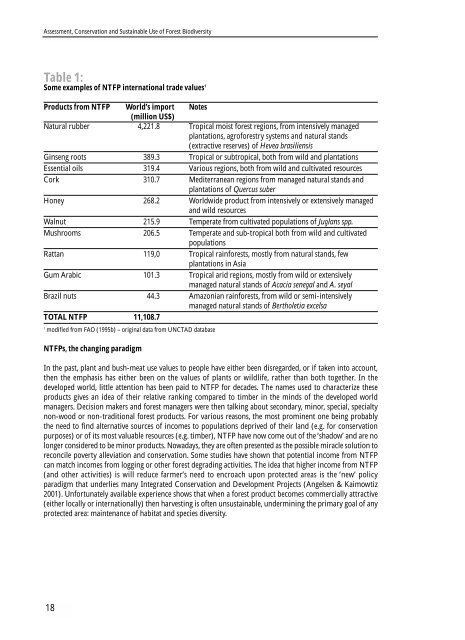Assessment, Conservation and Sustainable Use of Forest Biodiversity
Assessment, Conservation and Sustainable Use of Forest Biodiversity
Assessment, Conservation and Sustainable Use of Forest Biodiversity
Create successful ePaper yourself
Turn your PDF publications into a flip-book with our unique Google optimized e-Paper software.
<strong>Assessment</strong>, <strong>Conservation</strong> <strong>and</strong> <strong>Sustainable</strong> <strong>Use</strong> <strong>of</strong> <strong>Forest</strong> <strong>Biodiversity</strong><br />
Table 1:<br />
Some examples <strong>of</strong> NTFP international trade values 1<br />
Products from NTFP World’s import Notes<br />
(million US$)<br />
Natural rubber 4,221.8 Tropical moist forest regions, from intensively managed<br />
plantations, agr<strong>of</strong>orestry systems <strong>and</strong> natural st<strong>and</strong>s<br />
(extractive reserves) <strong>of</strong> Hevea brasiliensis<br />
Ginseng roots 389.3 Tropical or subtropical, both from wild <strong>and</strong> plantations<br />
Essential oils 319.4 Various regions, both from wild <strong>and</strong> cultivated resources<br />
Cork 310.7 Mediterranean regions from managed natural st<strong>and</strong>s <strong>and</strong><br />
plantations <strong>of</strong> Quercus suber<br />
Honey 268.2 Worldwide product from intensively or extensively managed<br />
<strong>and</strong> wild resources<br />
Walnut 215.9 Temperate from cultivated populations <strong>of</strong> Juglans spp.<br />
Mushrooms 206.5 Temperate <strong>and</strong> sub-tropical both from wild <strong>and</strong> cultivated<br />
populations<br />
Rattan 119,0 Tropical rainforests, mostly from natural st<strong>and</strong>s, few<br />
plantations in Asia<br />
Gum Arabic 101.3 Tropical arid regions, mostly from wild or extensively<br />
managed natural st<strong>and</strong>s <strong>of</strong> Acacia senegal <strong>and</strong> A. seyal<br />
Brazil nuts 44.3 Amazonian rainforests, from wild or semi-intensively<br />
managed natural st<strong>and</strong>s <strong>of</strong> Bertholetia excelsa<br />
TOTAL NTFP 11,108.7<br />
1<br />
modified from FAO (1995b) – original data from UNCTAD database<br />
NTFPs, the changing paradigm<br />
In the past, plant <strong>and</strong> bush-meat use values to people have either been disregarded, or if taken into account,<br />
then the emphasis has either been on the values <strong>of</strong> plants or wildlife, rather than both together. In the<br />
developed world, little attention has been paid to NTFP for decades. The names used to characterize these<br />
products gives an idea <strong>of</strong> their relative ranking compared to timber in the minds <strong>of</strong> the developed world<br />
managers. Decision makers <strong>and</strong> forest managers were then talking about secondary, minor, special, specialty<br />
non-wood or non-traditional forest products. For various reasons, the most prominent one being probably<br />
the need to find alternative sources <strong>of</strong> incomes to populations deprived <strong>of</strong> their l<strong>and</strong> (e.g. for conservation<br />
purposes) or <strong>of</strong> its most valuable resources (e.g. timber), NTFP have now come out <strong>of</strong> the ‘shadow’ <strong>and</strong> are no<br />
longer considered to be minor products. Nowadays, they are <strong>of</strong>ten presented as the possible miracle solution to<br />
reconcile poverty alleviation <strong>and</strong> conservation. Some studies have shown that potential income from NTFP<br />
can match incomes from logging or other forest degrading activities. The idea that higher income from NTFP<br />
(<strong>and</strong> other activities) is will reduce farmer’s need to encroach upon protected areas is the ‘new’ policy<br />
paradigm that underlies many Integrated <strong>Conservation</strong> <strong>and</strong> Development Projects (Angelsen & Kaimowtiz<br />
2001). Unfortunately available experience shows that when a forest product becomes commercially attractive<br />
(either locally or internationally) then harvesting is <strong>of</strong>ten unsustainable, undermining the primary goal <strong>of</strong> any<br />
protected area: maintenance <strong>of</strong> habitat <strong>and</strong> species diversity.<br />
18

















